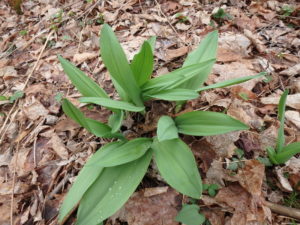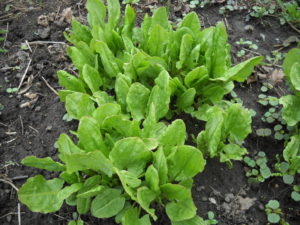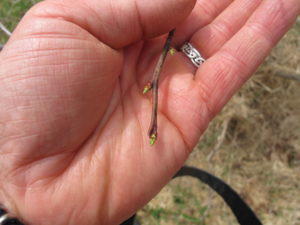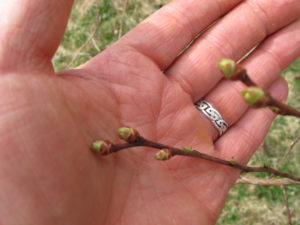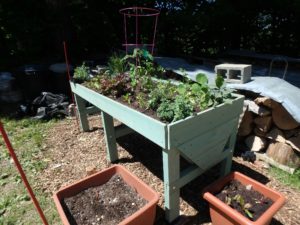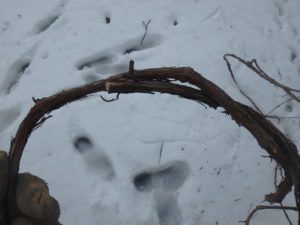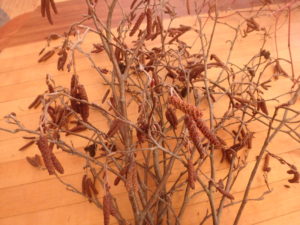A Taste of Spring!
I’m already eating a few of my own fresh vegetables: ramps, dandelion greens and sorrel are ready, and soon will come those perennial delicacies, asparagus and rhubarb.
It took me nearly 10 years, but I now have a patch of ramps that produces enough of these wild members of the onion family that I don’t have to go hiking to dig up the ramps I need. I sauté both the bulb and the leaves, and find them a great spring treat in eggs or a stir fry.
Ramps are often found in areas with moist soil and filtered sun and shade. They are slow-growing, but I have added 50 or so plants most years for 10 years and the older clumps are ready for harvesting.
Ramps often are found in patches of a million or more, but that does not mean you can be careless about harvesting them – a patch that sizes takes a lifetime or more to develop. Dig a few in one spot, move to another – and never take all from any one location. If I dig out 25 from one spot, I am sure to leave half a dozen in the ground.
If you want to start your own patch, first learn to identify the plant. They have leaves that are 6 to 12 inches long and 1 to 3 inches wide with a pointy end. There is a groove down the middle of the leaf, and the lower stem may have some maroon coloring. And the scent is distinct, similar to garlic and leeks. The bulbs are half an inch wide or so, and two inches long or less, depending when you pull them. There is an outer sheath over the bulb which you should slide off when you cut off the roots.
To grow your own, carefully observe where you find them in the wild. Look at the trees: often maples and beech, sometimes ash or poplar form the canopy. Wildflowers that grow along with ramps include spring beauty, Dutchman’s breeches and trout lily.
The soil for growing ramps should be rich and dark. If you want some near the house and kitchen, dig some up and try to match the environment where you find them in the wild. Be sure to ask the landowner if you want to take some from a neighbor. These are spring ephemerals, so the leaves will die and disappear before mid-summer.
I know that many gardeners think of dandelions as pests, and they can be. But they are also tasty if you dig some before they bloom; after blooming they tend to get bitter.
To harvest dandelions, bring a table knife with you to a patch of lawn or garden that has not been treated with chemicals – no herbicides, no chemical fertilizers, no pesticides. Slice the roots an inch beneath the soil surface and lift the dandelion carefully as you don’t want to sprinkle any soil onto the greens. The white portion just beneath the soil is delicious, but you can toss the brown-skinned tap root.
I wash the dandelions with the sprayer in my kitchen sink, and then leave the roots in a bowl of water to loosen any more soil. Then I return and rinse them after soaking. I like to steam them lightly, then serve with cider vinegar or a little butter. Although I eat them the same day I pick them, my late friend Rev Wightman used to freeze them and eat them throughout the year.
Sorrel is a great favorite of French cooks who make a soup with it. Although I grow it, I am not wild about it. It is a bright leafy green that comes back, year after year. It has a sharp lemony flavor, a bit like wood sorrel. My problem with it is that when you cook it, it practically disappears. It has little substance. But it’s easy to grow, and adds a unique flavor if added to a salad or even a sandwich. Plants are often sold at garden centers in the herb section.
My rhubarb is up! I love rhubarb for its sharp flavor, one that I have been told is among the last to disappear for the elderly when they lose their ability to sense flavors.
Rhubarb is easy to grow. It does best in full sun with rich moist soil. I have grown it in dry soil and although it grows in dry places, it is not as vigorous. It has a deep fleshy root. If you have a friend with a rhubarb patch, it is easy to dig some out and bring it home. Just plunge a spade into the middle of a plant, and then around it, and lift out a section of root. Add plenty of compost and organic fertilizer to the soil when you plant it.
Rhubarb comes in green-stemmed and red-stemmed varieties. I like the red, though I doubt there is a difference in taste. The leaves are a little toxic – they contain oxalic acid – but are not going to kill you if you eat some.
For a spring drink, chop a pound of stems, add water, and boil until soft. Drain off the mush, add some sugar and more water for a tasty pink drink that has got to be healthier for you than soda!
Eating seasonally is good for you – and I like having treats now that I only get once a year. Soon fiddleheads will be up – but more on that another day.
Henry’s blog appears twice a week at https://dailyuv.com/
How to Prune Your Blueberries
I recently spent half a day helping a friend prune her blueberries. Some rows hadn’t been tended too in a couple of years or more, and had gotten very bushy and overgrown. It is very satisfying work, knowing that bushes will produce better and be easier to pick once they have been pruned.
The first thing I did was cut out branches that had flopped over and were spread out in the walkways. It is important for both pickers and mowers to be able to go up and down the rows easily. I didn’t just cut off the ends of the intruding branches, I cut them back to their points of origin near the center of the bushes, just above the soil line. To do that, I used some nice geared loppers made by Fiskars to cut back the thick stems that were in the way. These geared loppers are 32 inches long and have a mechanical advantage built in which facilitates cutting stems up to an inch and a half without straining. The long handles meant I didn’t have to crawl into the bush to get to the base of a stem.
One note about spacing of blueberry bushes: gardeners often try to pack as many plants into a space as possible. Don’t. Crowding blueberries makes working in them more difficult. Space rows 10 feet apart at planting time. That might seem excessive, but it will be a big help later. The minimum space between plants should be 6 feet, and 8 feet is even better.
After clearing out walking space, I went down the rows with my hand pruners. I removed all dead branches. These have no fruit buds and are gray and flakey. Follow the branch back to its point of origin and cut back there. Some branches that appear dead have live side branches on them that you may want to keep.
It’s important to be able to quickly differentiate between fruit buds and leaf buds. A fruit bud is fat and somewhat round. A leaf bud is smaller, and is narrow and pointy. A branch that is dominated by leaf buds is less valuable to you than one that has lots of fruit buds, though the fruit buds also produce leaves – and a cluster of berries. If you see no fruit buds on a stem, prune it out.
What else? When deciding between two competing branches, remove the older, less vigorous branch and leave younger stems, which on blueberries often have a green or reddish color. Prune away branches that are damaged or rubbing against another branch. In general, branches should be grow out, away from the center of the bush. Branches that aim into the middle will eventually cause problems.
Blueberries sometimes develop a viral infection that causes “witches brooms.” These are masses of fine twigs growing on one branch. Remove the entire thing and put it in the trash, or burn it.
Blueberries really are easy to grow. They need full sun, which means a minimum of six hours per day. But most importantly, they need very acidic soil. Now would be a good time to collect a soil sample and send it off for testing at your state Cooperative Extension laboratory. You can download the form on-line, just Google “soil testing” and your state.
If your soil is not acidic enough, you can add elemental sulfur. This is fine for organic gardeners, too, as it is mined from the earth, not manufactured in a chemical plant. You can add sulfur anytime, just follow the directions on the package. If you use an acidic fertilizer described as good for acid-loving plants, spread that right after the bushes bloom in June.
Changing the soil pH may take you a number of years. It is better to add some this year, and again next year (and in later years) than to dump too much on at once. Your ultimate goal is a pH in the range of 4.0 to 5.0. The scale is logarithmic, meaning that 4.0 is ten times more acidic than 5.0, and a hundred times more acidic than 6.0. Seven on the scale is neutral.
Many gardeners dread pruning, perhaps because they imagine cutting off branches as like removing limbs of a person or animal. Pruning is not. It’s more like getting a haircut. It is an essential part of maintaining a good-looking, productive plant. There is no deadline for when you must stop pruning, though the later you wait, the more buds will fall off as you work on the bushes – so get started soon!
Get used to pruning, and you will have more and better fruit. And for me, spending time outdoors in early spring is much more fun than being indoors on a computer.
Henry Homeyer is the author of four gardening books and a children’s chapter book, Wobar. Check out his website at https://gardening-guy.com.
Planting for the Unique Umami Flavor
Umami is the fifth flavor we humans can detect, along with sweet, sour, bitter and salty. It is much more difficult to describe or quantify than the 4 standard flavors because we haven’t been raised to recognize it. I call it the flavor of contentment. The Japanese translate it, roughly, as “deliciousness.”
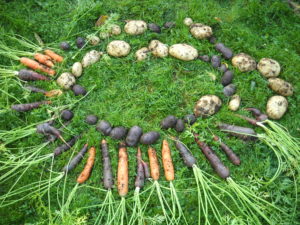 Scientists have determined that there are receptors in our taste buds that are stimulated by umami, just as there are for salty or sweet. They send signals to our brain that says, “Oh boy, something really good is here!” The orbitofrontal cortex (right above the eyes) registers a highly pleasant sensation. Yum, it says.
Scientists have determined that there are receptors in our taste buds that are stimulated by umami, just as there are for salty or sweet. They send signals to our brain that says, “Oh boy, something really good is here!” The orbitofrontal cortex (right above the eyes) registers a highly pleasant sensation. Yum, it says.
The umami flavor is created when certain amino acids that contribute to protein formation are present, notably glutamate, inosinate and guanylate. Seaweeds are highest in these components, but seafood, meats and certain vegetables contain them, too. Oh, and it is found in breast milk. Maybe that’s why we like it.
So what vegetables contain natural glutamate? Ripe tomatoes are highest of ordinary vegetables, which does not surprise me at all. Actually, dried tomatoes are even better because most of the water is gone. What else? Garlic, green peas and corn are excellent, as are beans, potatoes and carrots. Does that sound like a list of comfort foods? It does to me.
Mushrooms and fermented foods like soy sauce are good umami producers, as is cheese. Parmigiano-Reggiano cheese is particularly high, but cheddar is good, too.
If you want the highest level of flavor in your foods, grow it yourself. Pick your tomatoes dead ripe. That’s when the levels of umami-producing amino acids are at their highest.
Busy people say they have no time for a vegetable garden. Perhaps. But if you know that you can grow food that is super tasty, maybe you’d find some time. Here are 5 ways to get your umami-rich foods without dedicating your life to them.
- Get a big self-watering pot and plant one “patio tomato” in it. This pot should be roughly the size of a 5-gallon pail and have a water reservoir so it won’t dry out if you forget to water for a few days. Or go to the beach for the weekend. Fill it with a 50-50 mix of compost and potting soil. Put it in full sun in the middle of your lawn or along the driveway.
- Shiitake mushrooms are very high in umami. I have inoculated hardwood logs with spore plugs that eventually produce shiitakes. But it’s sort of like fishing, you never know when your logs will produce, or for how many years. But now companies are producing mushroom kits that come ready to go. Most of those are one-time kits that produce just one flush of mushrooms, but they’re easy.
- Potatoes are some of the easiest veggies to grow, and are good umami producers. If you want to tear up a 10-foot by 12-foot patch of lawn, you can become potato self-sufficient – for a year! You can build wide raised beds with a walkway down the middle and a little free space around the edges. Plant seed potatoes 18 inches apart and you can grow a lot of food.
- Then there is the Veg Trug. I had one last summer and loved it. About 6 feet long and 2.5 feet wide, it is a nice cedar planting trough on legs that is V-shaped in cross-section, so it is deep enough for tomatoes or potatoes. And you don’t have to bend over to pull weeds or harvest herbs. I grew lots of lettuce, herbs and one tomato. I got mine from Gardener’s Supply (gardeners.com or 888-833-1412).
- Visit your local farm stand, farmers market or, better yet, sign up now for a CSA. You don’t actually have to grow your own food just to get fresh produce at the peak of its flavor and ripeness.
The fact that we have receptors that are just for umami tells me that umami is something that is good for us. After all, our mouth also tells us when something is not good for us. We have evolved to recognize foods that are healthy. We respond well to sweets and fats because eons ago we needed calories to stay alive. Now, of course, we need to stay away from too much of those.
All this says you could and should grow your own food, and then cook it from scratch. I have written more than once that “Tomatoes are the queen of the garden.” In August I eat ripe tomatoes for breakfast, lunch and dinner. Why? I guess all this time I thought it was free will. Now I know it is an addiction to – or an affinity for – umami. Now is the time to plan your garden for the summer.
Read my twice-weekly blog at https://dailyuv.com/
How to Make a Spring Wreath
Mud season for many gardeners is bleak. Raw days of gray and rain mean it’s not fun to spend time outdoors, so we wither on the vine. Thankfully, I start lots of seedlings indoors, and early April is the right time to start most vegetables and flowers. But even that doesn’t keep me very busy – and I tend to get squirrelly.
I recently went outside to harvest materials for making a spring wreath, and then made one on the kitchen counter. It perked up my spirits considerably, so I am sharing my technique here – along with some tips about growing what you need for making spring wreathes in years to come.
Here is what you need: several lengths of freshly cut grape vines, each piece 5 to 15 feet long and a quarter to a half an inch in diameter; 25 stems of pussy willows, 25 stems of red-twigged dogwood, and a dozen or so stems of alder with fresh catkins. The stems are all found in moist places alongside the road, or at the edge of a stream or swamp.
Wild grapes are a pest vine for many of us, climbing up trees and strangling them, so pulling some down and using them for a wreath is a good thing to do. Of course this is the time to prune eating and wine grapes, and you may be able to gather enough vines on your domestic plants to make a wreath base.
I went to the woods and cut a 15-foot length of grapevine that was about as thick around as my ring finger. It is important to use living, not dead, vines; the one I cut was a greenish white inside and flexible, so I knew it was alive when I cut it. Dead vines are brittle and not suitable.
To make the wreath form a vine circle 14 to 16 inches in diameter by overlapping (or twisting) one half of the vine over the other half – the same way you would start to tie your shoelaces. Then grasp one of the loose ends and weave it around the vine circle in loops, over and under, pulling it tight as you go. After each piece of vine is in place squeeze the circle to make it regular in shape.
When you run out of vine, tuck the end into the circle and repeat the maneuver with the other end of the vine. Then use shorter, thinner pieces of vine – say 6 to 8 feet long and pencil-thick – and weave them around the wreath base until you have a circle 2 inches or more thick. It’s hard to make a nice round circle of vine, and mine was a little lopsided.
The great thing about this grapevine wreath is that you can just slide stems of pussy willows in between the vines and natural tension will hold them in place. In fact, I had to use a screwdriver to lift the vines at times in order to slide the stems in place.
I went around first with pussy willows stems, poking them into the grape vine base every 4 inches of so. Then I added stems of alders with their nice catkins, and finally I slid in clusters of the red-twigged dogwoods. I hung the wreath up where I could work on it and was better able to see where there were spaces that needed twigs, and added a few more.
A few notes on growing these plants. Pussy willows love to grow in wet places and require no care. You can start them as soon as the ground thaws and the bushes leaf out. Just cut 12-inch branches, strip off the leaves, and push them 8 inches into the soil. They will root where there are leaf nodes.
In addition to growing in the wild, red-twigged dogwood is a nice landscape plant available at any garden center. Stems can grow up to 3 feet in a year, and some gardeners cut the plant right to the ground each spring (once it is a few years old and has well established root systems.) They do that as the stems are most brilliantly colored in their first year of growth. Or you can remove a third of the stems each year, which is what I do.
Alders? They grow wild by my stream and I have to admit I have never seen plants for sale. They are messy plants that tend to flop over and root in. But they are nitrogen-fixing shrubs that will improve the soil in wastelands or alongside the road. I imagine you can root them in the spring just like willows. But they’re not for urban gardeners or small lots.
My wreath is not a professional job, but it pleases me every time I see it. That’s important in mudseason. And after I made mine, we got another foot of snow! March went out like a lion here where I live.
Read Henry’s twice a week blog at www.dailyUV.com. His e-mail is henry.homeyer@comcast.net and you may reach him at PO Box 364, Cornish Flat, NH 03746. Henry’s personal website is www.Gardening-Guy.com.



